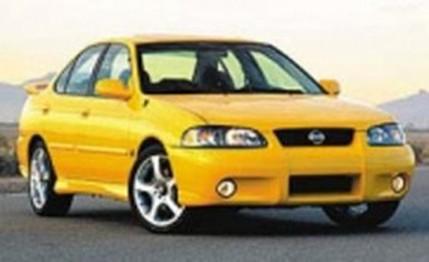 First Drive Review
First Drive Review
A bounding fawn running at full speed looks almost weightless. Most of its forward motion is accomplished in the air. Its skinny legs only touch down for split seconds at a time, propelling the animal forward-darting, lithe, agile. It has no visible musculature, and certainly no sign of fat. It's all a blur of motion. We followed one such fawn for about a half-mile down delightfully twisting little Cachagua Road east of Carmel Valley in California.
We thought of passing, keeping the revs in the meat of the power curve for a squirt past. Every time we'd think of making our pass on this one-and-a-half-lane country road, the fawn would dive down to the inside of the turn. "He's clipping the apexes!" we said in absolute astonishment. The little braveheart was clearly blocking us. Finally, with no encouragement from us, the fawn hopped off the right side of the road and down a wooded embankment. What does this have to do with the 2002 Nissan Sentra SE-R Spec V that we were driving during the encounter? Well, nothing really.
You thought maybe we'd tell you what a lithe little fawn of a car the new SE-R is? Nope. It's nothing like that. Owing to its new, large-displacement four-cylinder-25 percent larger than the engine of any competing car-and 180 pound-feet of torque, the SE-R Spec V would more accurately be described as "strong and forceful" than "light and graceful." It's more wild boar than Bambi.After a seven-year absence, the Sentra SE-R returns as the muscle car of pocket rockets. (The unloved 200SX SE-R that arrived in 1995 wasn't much of a replacement.) The original 1991-94 Sentra SE-R won a spot on Car and Driver's 10Best list every year it was sold in the U.S. Although its 2.0-liter twin-cam four spun happily beyond 7000 rpm, the ample midrange torque of the engine was what distinguished it from the contemporary Honda Civic Si, Acura Integra, and Mazda MX-3.
The 2002 SE-R Spec V differs from the old SE-R not so much in character as in magnitude. The sedan proportions, the torquey engine, the value, and the limited-slip differential-all the elements that defined the original-are present and accounted for. But there's more tire, more weight, and more torque than before. Counting on pleasant memories conjured by the SE-R moniker, the marketing types decided there would be two SE-Rs-a "standard" SE-R and the SE-R Spec V. The standard model takes the place of the SE. It is powered by a new 2.5-liter engine (making 170 horsepower), but it doesn't have the sport-tuned suspension or six-speed manual of the Spec V.
The one we're more interested in-and the version we drove at Laguna Seca Raceway and throughout the Carmel Valley-is the top-performing Spec V. Incidentally, the "Spec V" designation is Nissan's attempt to associate this highest-performance Sentra with the Japanese-market hyperperformance coupe, the Skyline GT-R V Spec. Either that, or the company just wanted to see how many letters and numbers would fit on the tail of a Sentra. The mechanical upgrades for the Spec V version are more compelling. Start with that new engine, which is virtually identical to the 2002 Altima's base engine. In this model, the 2.5-liter makes 10 more horsepower than in the standard SE-R, or 180 at 6000 rpm, and 180 pound-feet of torque at 4400 rpm. The extra grunt in Spec V trim is the work of a variable-volume exhaust system that opens a flap in the muffler for better exhaust flow at high revs.
The Spec V has 10 to 20 more horsepower than other pocket rockets, such as the upcoming Honda Civic Si, the Ford SVT Focus, and the Mini Cooper S, and vastly more than performance poseurs such as the Mitsubishi Lancer OZ Rally. Nissan estimates the Spec V will sprint to 60 mph in the high sixes. That's about a second quicker than the old SE-R and about two seconds before the 2001 SE model.
But there's more to the thrust story than peak horsepower. The Spec V's available torque-dramatically more than in competitors-is routed through a close-ratio six-speed manual transmission (the only transmission available in the Spec V) to a standard helical limited-slip differential. The limited slip, a real rarity in this class, allows the Spec V to absolutely rocket out of tight corners. Without the limited slip, the inside front tire would spin wildly or you'd have to restrain your right foot. And showing restraint isn't easy in the Spec V.